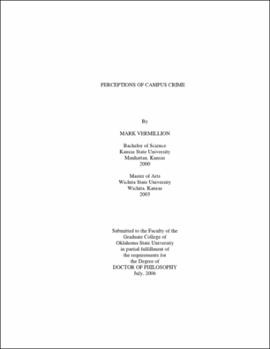| dc.contributor.advisor | Webb, Gary | |
| dc.contributor.author | Vermillion, Mark | |
| dc.date.accessioned | 2013-11-26T08:28:03Z | |
| dc.date.available | 2013-11-26T08:28:03Z | |
| dc.date.issued | 2006-07 | |
| dc.identifier.uri | https://hdl.handle.net/11244/7015 | |
| dc.description.abstract | Scope and Method of Study: The purpose of this research is to analyze campus crime from both a student perspective and a campus police officer perspective. Specifically, by employing literature from organizational deviance, community policing, traditional criminological variables explaining perceptions of crime, and framed within McGarrell and Castellano's Integrative Conflict Model this research attempts to locate what influences perceptions of campus crime for both students and campus police officers on both the structural (macro) and intermediate (meso) levels. Surveys measuring students' perceptions of campus crime and the campus police are distributed to a sample of a large public university located in the Southern United States as a way to measure the meso level of the theoretical framework. The sample is taken from large introductory courses and upper level courses from the College of Arts and Sciences. The final sample size is five hundred, eighteen surveys (N=518). On the structural level, interviews are conducted with campus police officers. Using Vaughan's nascent theory for the normalization of disasters in an organization as an a priori typology, interview transcripts are analyzed. | |
| dc.description.abstract | Findings and Conclusions: Statistical analyses done on the surveys collected reveal the current literatures do not adequately explain perceptions of both campus police and crime for the sample. The conclusion provided by this research is that more theory development needs to focus on the organizational and unique structure of campus communities. Previous theories developed upon community models do not appear to explain a high amount of variance within the dependent variable. Concerning the interview data, results reveal campus police officers' perceptions of campus crime are influenced by the web of miscommunication that occurs within the hierarchically structured, bureaucratic environments of institutions of higher education. The structure of both security departments and campus crime reporting procedures appear to influence security officials' perceptions of campus crime. Conclusions state circuitous reporting procedures engaged in by institutions are partly a result of the "dark side" of organizational life. | |
| dc.format | application/pdf | |
| dc.language | en_US | |
| dc.rights | Copyright is held by the author who has granted the Oklahoma State University Library the non-exclusive right to share this material in its institutional repository. Contact Digital Library Services at lib-dls@okstate.edu or 405-744-9161 for the permission policy on the use, reproduction or distribution of this material. | |
| dc.title | Perceptions of campus crime | |
| dc.contributor.committeeMember | Cross, John | |
| dc.contributor.committeeMember | Thrasher, Ron | |
| dc.contributor.committeeMember | Kirksey, Jason | |
| osu.filename | Vermillion_okstate_0664D_1901.pdf | |
| osu.accesstype | Open Access | |
| dc.type.genre | Dissertation | |
| dc.type.material | Text | |
| thesis.degree.discipline | Sociology | |
| thesis.degree.grantor | Oklahoma State University | |
